Nothing compares to the earthy aroma of fresh rye bread wafting through your kitchen — especially when it's made from scratch. This classic vegan rye bread with caraway seeds and molasses brings together the deep, slightly tangy flavor of rye flour, the subtle sweetness of molasses, and the warmth of caraway seeds for an old-world-style loaf that’s both hearty and comforting. Whether you’re looking to expand your go-to rye bread recipes or diving into the world of vegan rye bread for the first time, this loaf is a must-try. It’s perfect for sandwiches, served alongside a warm bowl of soup, or toasted and slathered with your favorite vegan spread.
Classic Vegan Rye Bread with Caraway Seeds and Molasses
Prep Time 15 minutes mins
Cook Time 45 minutes mins
Rising Time 4 hours hrs
Total Time 5 hours hrs
Course Breakfast, Side Dish, Snack
Cuisine German, Jewish, Russian, Scandinavian
Servings 1 large loaf (8–10 slices)
Large Mixing Bowl For combining ingredients and allowing the dough to rise.
Dutch Oven or Heavy Pot with Lid Essential for artisan-style crust. If you don’t have one, a baking sheet with an inverted bowl or foil dome can work.
Bench Scraper or Spatula Helps when shaping the sticky dough
Parchment paper Prevents sticking and makes transferring the dough easier.
Kitchen towel or plastic wrap For covering the dough during the rise.
Dry Ingredients
- 2 cups rye flour preferably stone-ground
- 1 cup all-purpose flour or bread flour
- 2 ¼ teaspoons instant yeast or one packet
- 1 ½ teaspoons sea salt
- 2 tablespoons caraway seeds
- ½ teaspoon ground coriander optional, but adds depth
Wet Ingredients
- 1 ½ tablespoons blackstrap molasses
- 1 ½ cups warm water about 105°F
- 1 tablespoon apple cider vinegar
Optional Topping
- Extra caraway seeds for sprinkling
- Cornmeal for dusting the baking surface
Mix the Dough
In a large mixing bowl, whisk together rye flour, all-purpose flour, yeast, salt, and caraway seeds. In a separate container, mix warm water with molasses and apple cider vinegar until combined. Pour the wet mixture into the dry ingredients and stir with a wooden spoon until a sticky, shaggy dough forms.
First Rise
Cover the bowl with a clean towel or plastic wrap. Let it rest at room temperature for about 3 to 4 hours, or until doubled in size. The dough will be very sticky — this is normal for high-hydration, low-gluten breads like this one.
Shape the Dough
Lightly flour your hands and a clean surface. Gently turn the dough out and fold it a few times to shape it into a ball. Don’t knead — just coax it into shape. Transfer to a piece of parchment paper sprinkled with cornmeal and dust the top with a bit of rye flour.
Second Rise
Cover loosely with a towel and let rise for another 30–45 minutes while your oven preheats.
Preheat Oven
Place your Dutch oven (with lid) inside your oven and preheat to 450°F for at least 30 minutes. This step helps create that crisp, chewy crust that’s characteristic of good artisan bread recipes.
Bake the Bread
Carefully remove the hot Dutch oven from the oven. Lift the dough with the parchment paper and place it into the pot. Cover with the lid and bake for 30 minutes. Remove the lid and bake for an additional 15 minutes to brown the top.
Cool
Remove the bread from the Dutch oven and let it cool on a wire rack for at least 1 hour before slicing. The interior is still finishing its baking process during this time, so patience is key.
Perfect Pairings
This vegan rye bread is incredibly versatile and holds up to both bold and subtle pairings:
- Hearty Soups: Lentil soup, vegan borscht, or a creamy chickpea stew are ideal. For a rich meal, try it with a smoked sausage and potato recipe (use vegan sausage for a plant-based meal).
- Avocado Toast: The tangy bread pairs wonderfully with mashed avocado, lemon, and chili flakes.
- Vegan Garlic Bread: Slice and toast with olive oil, garlic, and parsley for a rustic spin on garlic bread.
- Open-Faced Sandwiches: Top with hummus, roasted veggies, or vegan cheese for a nordic rye bread experience.
- Breakfast: Toast it and spread with vegan cream cheese, jam, or nut butter.
If you’re into baking, this dough also adapts well into vegan bagels by shaping and boiling before baking. Or try it with chickpea flour for a protein-packed twist similar to chickpea bread.
FAQs
1. Can I use a rye sourdough starter instead of yeast?
Absolutely! This bread works beautifully with a mature rye sourdough starter. Substitute the yeast with about ½ cup of active starter and reduce the water slightly. Keep in mind your rise times will be longer — often overnight.
2. Is this a 100% rye bread recipe?
No, this recipe uses a blend of rye and wheat flour to improve structure and texture. If you want a 100% rye bread recipe, you’ll need to adjust hydration levels and expect a denser crumb, more like traditional danish rye bread.
3. Can I make this bread gluten-free?
Rye contains gluten, though in lower amounts than wheat. For a gluten free vegan bread, you’ll need to use gluten-free flour blends designed for bread baking. While you won’t get the same chewy crumb, you can still create a tasty alternative.
4. What’s the difference between this and marble rye bread recipe?
Marble rye bread typically combines light and dark rye doughs twisted together. This version uses molasses for a dark, unified look. If you're curious, you could reserve part of the dough without molasses and swirl the two together for a beautiful marbled effect.
5. Can I freeze this bread?
Yes! Slice and freeze the loaf in a sealed bag. It toasts beautifully straight from the freezer. Perfect for busy mornings or when you just want a single slice with soup.
